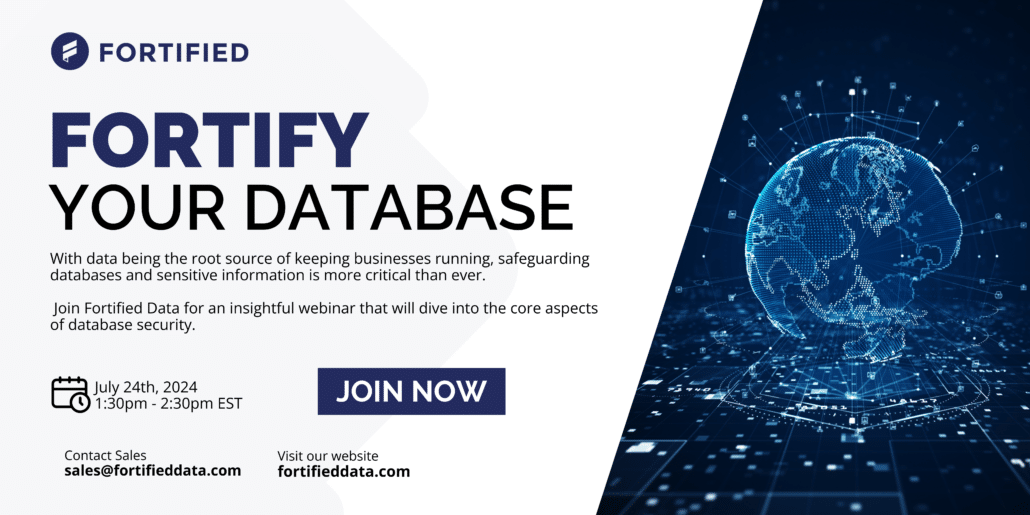Database Security: What Is It & How to Keep Your Database Secure
Databases are the backbone of virtually every organization, storing vast amounts of sensitive information ranging from customer data to proprietary business insights. As the volume and value of data continues to grow, so does the importance of safeguarding these critical assets. Database security has become a one of the biggest concerns for businesses, governments, and individuals alike, as it ensures the confidentiality, integrity, and availability of data.
The potential risks of database breaches are significant and far-reaching. A single breach can result in substantial financial losses, damage to an organization’s reputation, legal liabilities, and loss of customer trust. Additionally, regulatory compliance adds another layer of complexity to database security. Organizations must adhere to stringent data protection laws and standards, such as the General Data Protection Regulation (GDPR) and the Health Insurance Portability and Accountability Act (HIPAA).
Understanding and implementing highly-secure database security measures is essential. At Fortified Data, we are always staying at the forefront of understanding our client’s needs – especially as it comes to database security. With our in-depth knowledge, we are sharing this guide to take you through the fundamentals of database security, practical steps to secure your database, top tips for maintaining security, and methods for assessing your database’s security posture.
A Guide to Database Security
What is Database Security?
Database security encompasses a set of measures and practices aimed at protecting databases from unauthorized access, misuse, and malicious threats. At its core, database security is about ensuring three key aspects: confidentiality, integrity, and availability.
- Confidentiality: This involves protecting data from unauthorized access and disclosure. Ensuring that only authorized users and applications can access sensitive information is paramount.
- Integrity: This ensures that the data remains accurate, consistent, and trustworthy. It involves protecting data from being altered or corrupted by unauthorized users or processes.
- Availability: This ensures that data and database services are available to authorized users when needed. Protecting against disruptions, whether from cyberattacks or hardware failures, is crucial for maintaining continuous operation.
Database security encompasses various elements, including:
- Access Controls: Defining and enforcing who can access the database and what actions they can perform.
- Encryption: Protecting data by converting it into a secure format both at rest and in transit.
- Authentication and Authorization: Verifying the identity of users and granting them appropriate access levels.
- Auditing and Monitoring: Keeping track of database activities to detect and respond to suspicious behavior.
- Regular Updates and Patching: Ensuring database systems are up-to-date to protect against known vulnerabilities.
How to Secure Your Database
Securing your databases can be an in-house task that your IT team can manage, depending on the size of your database team, but by engaging a database managed service provider such as Fortified Data, the database security measures that need to be taken, actively, will be proactively taken care of. Here are some of the aspects of database security that should be done and/or considered in securing your database:
Access Control
Access control is a fundamental aspect of database security, encompassing mechanisms and policies that define who can access the database and what actions they are permitted to perform. Effective access control ensures that only authorized users can view, modify, or manage sensitive data, thereby protecting the database from unauthorized access and potential breaches.
This involves implementing role-based access control (RBAC), where users are assigned roles with specific permissions based on their job functions, and adhering to the principle of least privilege, which restricts users’ access rights to the minimum necessary for their roles. Additionally, sophisticated authentication methods, such as multi-factor authentication (MFA), enhance security by requiring users to provide multiple forms of verification before gaining access.
Encryption
Encryption is a vital component of database security. It involves converting data into a secure, unreadable format using cryptographic algorithms, making it accessible only to those who possess the decryption key.
There are two primary types of encryption relevant to database security: data-at-rest encryption and data-in-transit encryption. Data-at-rest encryption protects stored data on disks and backups, while data-in-transit encryption secures data as it travels across networks. Implementing strong encryption standards such as AES (Advanced Encryption Standard) for data at rest and TLS (Transport Layer Security) for data in transit is crucial.
Authentication and Authorization
Authentication and authorization are critical processes in database security that ensure only legitimate users gain access to the database and can perform authorized actions. Authentication verifies the identity of users, typically through usernames and passwords, but increasingly through more secure methods like multi-factor authentication (MFA), biometric verification, and single sign-on (SSO). Authorization, on the other hand, determines what an authenticated user is allowed to do within the database, enforcing policies that restrict access based on roles and permissions.
This is often managed through role-based access control (RBAC), where users are assigned specific roles that define their access levels.
Database Auditing and Monitoring
Database auditing and monitoring are essential practices for maintaining the integrity and security of a database. Auditing involves keeping detailed records of all database activities, including user logins, data modifications, and access attempts. These logs provide a comprehensive trail of actions that can be reviewed to detect and investigate suspicious activities.
Monitoring involves real-time surveillance of database operations to identify and respond to potential security incidents as they occur. Effective monitoring tools can alert administrators to unusual patterns or behaviors, such as repeated failed login attempts or unauthorized data access.
Together, auditing and monitoring enable organizations to maintain a proactive stance on security, quickly identifying and mitigating threats, ensuring compliance with regulatory requirements, and providing valuable insights for improving overall database security practices.
Regular Updates & Patching
Regular updates and patching are crucial for maintaining database security and protecting against vulnerabilities. Database software, like all software, can contain bugs and security flaws that are often targeted by cyber attackers.
Vendors regularly release updates and patches to address these issues, enhance security features, and improve overall performance. Implementing a robust patch management strategy ensures that these updates are applied promptly, reducing the window of opportunity for attackers to exploit known vulnerabilities. This involves not only applying patches to the database management system (DBMS) but also to related components such as operating systems, middleware, and applications. Automated patch management tools can help streamline this process, ensuring that updates are tested and deployed efficiently without disrupting operations.

Top Tips for Keeping Your Database Secure
Complete Regular Backups
Completing regular backups is a fundamental practice for database security, ensuring that data can be restored in the event of a breach, hardware failure, or other catastrophic events. Backups should be conducted frequently and stored securely, both on-site and off-site, to safeguard against data loss. Using automated backup solutions can help maintain consistency and reliability, reducing the risk of human error.
Additionally, encrypting backups and implementing strict access controls further protect the backup data from unauthorized access. Regularly testing backup and recovery procedures is also essential to ensure that data restoration processes are efficient and effective.
Use Strong Passwords
Using strong passwords is a critical aspect of database security, acting as the first line of defense against unauthorized access. Strong passwords are typically long, complex, and include a mix of uppercase and lowercase letters, numbers, and special characters.
Avoiding easily guessable information, such as common words, names, or sequential numbers, is crucial. Implementing policies that require regular password changes and preventing the reuse of old passwords can further enhance security. Password managers can be used to generate and store complex passwords, reducing the burden on users to remember them.
Limit User Access
Limiting user access is essential for minimizing the risk of unauthorized data manipulation and breaches. This principle, known as the principle of least privilege, involves granting users the minimum level of access necessary to perform their job functions. Implementing role-based access control (RBAC) helps in managing and assigning appropriate permissions based on user roles. Regularly reviewing and updating user access rights ensures that employees only have access to the data and resources they need, and any unnecessary permissions are revoked.
Regularly Review and Update Security Policies
Regularly reviewing and updating security policies is crucial to ensure they remain effective against evolving threats. Security policies should be dynamic documents that reflect current best practices, regulatory requirements, and emerging risks.
Periodic reviews, at least annually, allow organizations to assess the effectiveness of existing policies and make necessary adjustments. Engaging with stakeholders across the organization during these reviews ensures that policies are comprehensive and aligned with operational needs. Clear communication and enforcement of updated policies are essential to maintain a strong security posture.
Educate Employees
Educating employees is a vital component of database security, as human error and negligence are often significant vulnerabilities. Providing regular training on security best practices, such as recognizing phishing attempts, safe data handling, and the importance of strong passwords, empowers employees to act as the first line of defense against cyber threats. Tailored training programs that address specific roles and responsibilities within the organization can enhance understanding and compliance. Regularly updating training materials to reflect the latest security trends and threats ensures that employees remain vigilant and informed.
Complete Database Security Assessments
Completing database security assessments is essential for identifying vulnerabilities and ensuring robust protection measures are in place. These assessments can include vulnerability scanning, penetration testing, and comprehensive security audits. Vulnerability scanning tools help detect known weaknesses in the database system, while penetration testing involves simulated attacks to evaluate the effectiveness of security defenses. Regular security audits provide a thorough examination of security practices and compliance with relevant standards and regulations.
Here are some database security assessments to consider having done to test the security of your database:
- Vulnerability Scanning: Vulnerability scanning involves using automated tools to identify known security weaknesses within a database system. Regularly performing these scans helps organizations detect and address vulnerabilities before they can be exploited by malicious actors.
- Security Audits: Security audits are comprehensive evaluations of an organization’s database security practices and controls. These audits help ensure compliance with industry standards and regulations, providing a detailed analysis of potential security gaps and areas for improvement.
- Risk and Compliance Checks: Risk and compliance checks involve assessing the database for adherence to regulatory requirements and industry standards. These checks help organizations identify and mitigate risks associated with non-compliance, ensuring that they meet legal obligations and maintain robust security postures.
Database security is a critical aspect of protecting your organization’s valuable data from unauthorized access, breaches, and other threats. By taking proactive measures such as implementing strong access controls, using encryption, conducting regular backups, and educating employees, you can significantly enhance your database’s security.
However, the rapidly evolving landscape of cyber threats necessitates continuous vigilance and expertise. Fortified Data offers comprehensive risk and compliance assessments and managed services to help you review and strengthen your database security measures. By partnering with Fortified Data, you can ensure your database is proactively secured, allowing your team to focus on core business tasks with confidence. Don’t wait for a security breach to take action—contact Fortified Data today to safeguard your database and protect your organization’s future.
By leveraging Fortified Data’s managed services, organizations can enhance their database security, reduce the risk of breaches, and ensure compliance with regulatory requirements. Their expert team works as an extension of your IT department, providing peace of mind that your databases are secure and well-managed.



Leave a Reply
Want to join the discussion?Feel free to contribute!